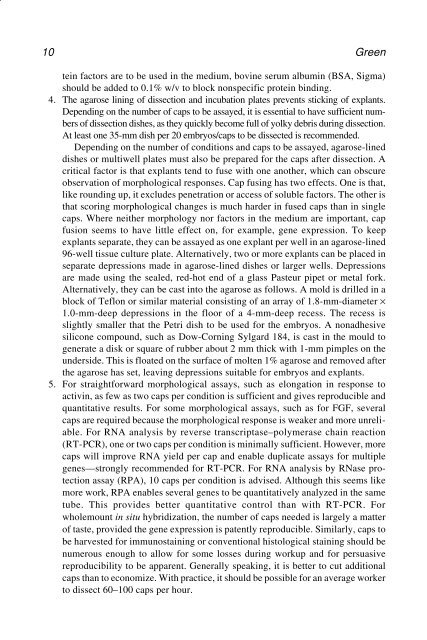Molecular Methods in Developmental Biology Molecular Methods in ...
Molecular Methods in Developmental Biology Molecular Methods in ...
Molecular Methods in Developmental Biology Molecular Methods in ...
- No tags were found...
You also want an ePaper? Increase the reach of your titles
YUMPU automatically turns print PDFs into web optimized ePapers that Google loves.
10 Greente<strong>in</strong> factors are to be used <strong>in</strong> the medium, bov<strong>in</strong>e serum album<strong>in</strong> (BSA, Sigma)should be added to 0.1% w/v to block nonspecific prote<strong>in</strong> b<strong>in</strong>d<strong>in</strong>g.4. The agarose l<strong>in</strong><strong>in</strong>g of dissection and <strong>in</strong>cubation plates prevents stick<strong>in</strong>g of explants.Depend<strong>in</strong>g on the number of caps to be assayed, it is essential to have sufficient numbersof dissection dishes, as they quickly become full of yolky debris dur<strong>in</strong>g dissection.At least one 35-mm dish per 20 embryos/caps to be dissected is recommended.Depend<strong>in</strong>g on the number of conditions and caps to be assayed, agarose-l<strong>in</strong>eddishes or multiwell plates must also be prepared for the caps after dissection. Acritical factor is that explants tend to fuse with one another, which can obscureobservation of morphological responses. Cap fus<strong>in</strong>g has two effects. One is that,like round<strong>in</strong>g up, it excludes penetration or access of soluble factors. The other isthat scor<strong>in</strong>g morphological changes is much harder <strong>in</strong> fused caps than <strong>in</strong> s<strong>in</strong>glecaps. Where neither morphology nor factors <strong>in</strong> the medium are important, capfusion seems to have little effect on, for example, gene expression. To keepexplants separate, they can be assayed as one explant per well <strong>in</strong> an agarose-l<strong>in</strong>ed96-well tissue culture plate. Alternatively, two or more explants can be placed <strong>in</strong>separate depressions made <strong>in</strong> agarose-l<strong>in</strong>ed dishes or larger wells. Depressionsare made us<strong>in</strong>g the sealed, red-hot end of a glass Pasteur pipet or metal fork.Alternatively, they can be cast <strong>in</strong>to the agarose as follows. A mold is drilled <strong>in</strong> ablock of Teflon or similar material consist<strong>in</strong>g of an array of 1.8-mm-diameter ×1.0-mm-deep depressions <strong>in</strong> the floor of a 4-mm-deep recess. The recess isslightly smaller that the Petri dish to be used for the embryos. A nonadhesivesilicone compound, such as Dow-Corn<strong>in</strong>g Sylgard 184, is cast <strong>in</strong> the mould togenerate a disk or square of rubber about 2 mm thick with 1-mm pimples on theunderside. This is floated on the surface of molten 1% agarose and removed afterthe agarose has set, leav<strong>in</strong>g depressions suitable for embryos and explants.5. For straightforward morphological assays, such as elongation <strong>in</strong> response toactiv<strong>in</strong>, as few as two caps per condition is sufficient and gives reproducible andquantitative results. For some morphological assays, such as for FGF, severalcaps are required because the morphological response is weaker and more unreliable.For RNA analysis by reverse transcriptase–polymerase cha<strong>in</strong> reaction(RT-PCR), one or two caps per condition is m<strong>in</strong>imally sufficient. However, morecaps will improve RNA yield per cap and enable duplicate assays for multiplegenes—strongly recommended for RT-PCR. For RNA analysis by RNase protectionassay (RPA), 10 caps per condition is advised. Although this seems likemore work, RPA enables several genes to be quantitatively analyzed <strong>in</strong> the sametube. This provides better quantitative control than with RT-PCR. Forwholemount <strong>in</strong> situ hybridization, the number of caps needed is largely a matterof taste, provided the gene expression is patently reproducible. Similarly, caps tobe harvested for immunosta<strong>in</strong><strong>in</strong>g or conventional histological sta<strong>in</strong><strong>in</strong>g should benumerous enough to allow for some losses dur<strong>in</strong>g workup and for persuasivereproducibility to be apparent. Generally speak<strong>in</strong>g, it is better to cut additionalcaps than to economize. With practice, it should be possible for an average workerto dissect 60–100 caps per hour.












